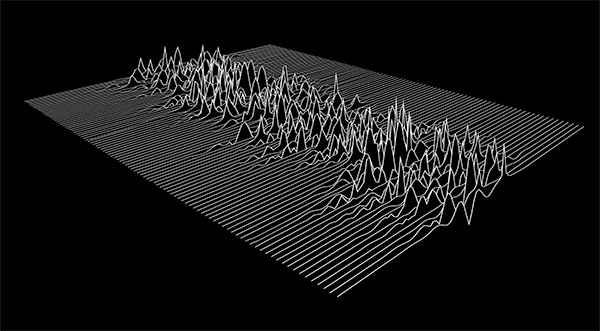40 years ago, the English rock band Joy Division released their debut album, Unknown Pleasures. The cover of the album is now iconic, and features a series of lines that indicate radio emissions from a pulsar, PSR B1919+21. It was the first radio pulsar ever discovered. Pulsars are incredibly massive objects, and the remnants of dead stars much more massive than the Sun. After the star goes nova, it leaves behind a dense core, known as a neutron star. A spinning neutron star is called a pulsar. Each of the 80 lines on the album cover featuring measurements of PSR B1919+21 corresponds to a turn in the pulsar. Think of it like a lighthouse, where the beam crosses an observer periodically. Only, the light is not always of the same brightness, and is in the radio spectrum. These differences in brightness cause the wavy lines in the measurement. The pulsar made 80 turns over a period of 107 seconds. The original observation was published in a PHD thesis by Harold Craft. It found its way to an encyclopedia read by Joy Division lead guitarist Bernard Sumner. The band's graphic designer, Peter Saville based the album cover on this image.

Now, 40 years later, astronomers from the University of Manchester observed PSR B1919+21 to mark the anniversary of the album release. When the album was originally published, little was known about the pulsars. The changes in the brightness of the radio flashes were thought to be chaotic and random. Scientists can now see periodic waxing and waning of the brightness of pulsars, a pattern that can be observed in some pulsars. Researchers now know that the radio waves are produced by high energy particles moving at nearly the speed of light, created from electrical discharges from the ionised gas surrounding the pulsar. Essentially, the wavy lines represent lightning in outer space.
Interestingly, when researchers first observed the pulsar, they had seen nothing like it, and the periodic radio flashes made it look like the object was artificial in originl. The object was designated as LGM-1 (for little green men). Apart from being the inspiration for the Joy Division album cover, PSR B1919+21 has also inspuired a Max Richter composition, Journey (CP1919).
Source: University of Manchester
from Latest Technology News https://ift.tt/2JDEdLn









